Related Research Articles

Cream is a dairy product composed of the higher-fat layer skimmed from the top of milk before homogenization. In un-homogenized milk, the fat, which is less dense, eventually rises to the top. In the industrial production of cream, this process is accelerated by using centrifuges called "separators". In many countries, it is sold in several grades depending on the total butterfat content. It can be dried to a powder for shipment to distant markets, and contains high levels of saturated fat.
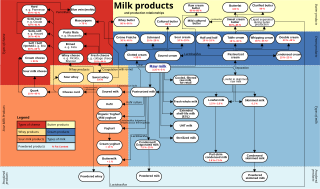
Dairy products or milk products, also known as lacticinia, are food products made from milk. The most common dairy animals are cow, water buffalo, nanny goat, and ewe. Dairy products include common grocery store food around the world such as yogurt, cheese, milk and butter. A facility that produces dairy products is a dairy. Dairy products are consumed worldwide to varying degrees. Some people avoid some or all dairy products because of lactose intolerance, veganism, environmental concerns, other health reasons or beliefs.

Milk is a white liquid food produced by the mammary glands of mammals and the caecilian Siphonops annulatus. It is the primary source of nutrition for young mammals before they are able to digest solid food. Immune factors and immune-modulating components in milk contribute to milk immunity. Early-lactation milk, which is called colostrum, contains antibodies that strengthen the immune system and thus reduce the risk of many diseases. Milk contains many nutrients, including calcium and protein, but also lactose and saturated fat.
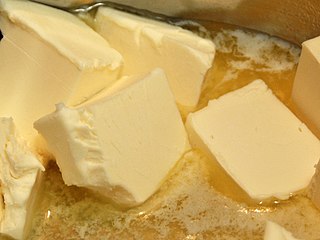
Butter is a dairy product made from the fat and protein components of churned cream. It is a semi-solid emulsion at room temperature, consisting of approximately 80% butterfat. It is used at room temperature as a spread, melted as a condiment, and used as a fat in baking, sauce-making, pan frying, and other cooking procedures.
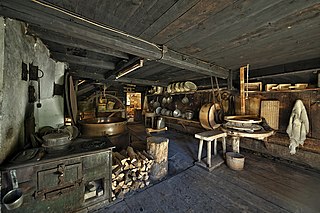
A dairy is a place where milk is stored and where butter, cheese and other dairy products are made, or a place where those products are sold. It may be a room, a building or a larger establishment. In the United States, the word may also describe a dairy farm or the part of a mixed farm dedicated to milk for human consumption, whether from cows, buffaloes, goats, yaks, sheep, horses or camels.

Brie is a soft cow's-milk cheese named after Brie, the French region from which it originated. It is pale in color with a slight grayish tinge under a rind of white mould. The rind is typically eaten, with its flavor depending largely upon the ingredients used and its manufacturing environment. It is similar to Camembert, which is native to a different region of France. Brie typically contains between 60% and 75% butterfat, slightly higher than Camembert.

The Jersey is a British breed of small dairy cattle from Jersey, in the British Channel Islands. It is one of three Channel Island cattle breeds, the others being the Alderney – now extinct – and the Guernsey. The milk is high in butterfat and has a characteristic yellowish tinge.

The Guernsey is a breed of dairy cattle from the island of Guernsey in the Channel Islands. It is fawn or red and white in colour, and is hardy and docile. Its milk is rich in flavour, high in fat and protein, and has a golden-yellow tinge due to its high β-carotene content. The Guernsey is one of three Channel Island cattle breeds; the other two are the Alderney, which is now extinct, and the Jersey.

Dairy cattle are cattle bred with the ability to produce large quantities of milk, from which dairy products are made. Dairy cattle generally are of the species Bos taurus.

Skyr is a traditional Icelandic cultured dairy product. It has the consistency of strained yogurt, but a milder flavor. Skyr can be classified as a fresh sour milk cheese, similar to curd cheese consumed like a yogurt in the Baltic states, the Low Countries and Germany. It has been a part of Icelandic cuisine for centuries.
Butterfat or milkfat is the fatty portion of milk. Milk and cream are often sold according to the amount of butterfat they contain.
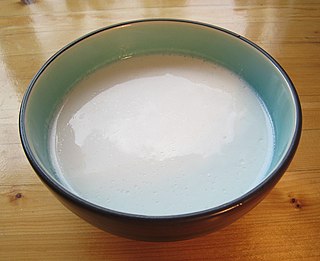
Plant milk is a plant beverage with a color resembling that of milk. Plant milks are non-dairy beverages made from a water-based plant extract for flavoring and aroma. Plant milks are consumed as alternatives to dairy milk, and may provide a creamy mouthfeel.

A2 milk is a variety of cows' milk that mostly lacks a form of β-casein proteins called A1, and instead has mostly the A2 form. Cows' milk like this was brought to market by The a2 Milk Company and is sold mostly in Australia, New Zealand, China, and the United States. It was sold in the United Kingdom between 2012 and 2019. Non-cow milk, including that of humans, sheep, goats, donkeys, yaks, camels, buffalo, and others, also contain mostly A2 β-casein, and so the term "A2 milk" is also used in that context.

The Alderney is an extinct breed of dairy cattle. It originated in, and is named for, the island of Alderney in the Channel Islands. It was one of three breeds of Channel Island cattle, the others being the Jersey and the Guernsey. In the eighteenth and nineteenth centuries "Alderney" was a general term for cattle from the archipelago; many were exported to mainland Britain under this name, regardless of which of the islands they came from.

Goat milk is the milk of domestic goats. Goats produce about 2% of the world's total annual milk supply. Some goats are bred specifically for milk. Goat milk naturally has small, well-emulsified fat globules, which means the cream will stay in suspension for a longer period of time than cow's milk; therefore, it does not need to be homogenized. Eventually, the cream will rise to the top over a period of a few days. If the milk is to be used to make cheese, homogenization is not recommended, as this changes the structure of the milk, affecting the culture's ability to coagulate the milk and the final quality and yield of cheese.

The fat content of milk is the proportion of milk, by weight, made up by butterfat. The fat content, particularly of cow's milk, is modified to make a variety of products. The fat content of milk is usually stated on the container, and the color of the label or milk bottle top varied to enable quick recognition.

Dairy farming in New Zealand began during the early days of colonisation by Europeans. The New Zealand dairy industry is based almost exclusively on cattle, with a population of 4.92 million milking cows in the 2019-20 season. The income from dairy farming is now a major part of the New Zealand economy, becoming an NZ$13.4 billion industry by 2017.

Vegan cheese is a category of non-dairy, plant-based cheese analogues. Vegan cheeses range from soft fresh cheeses to aged and cultured hard grateable cheeses like plant-based Parmesan. The defining characteristic of vegan cheese is the exclusion of all animal products.
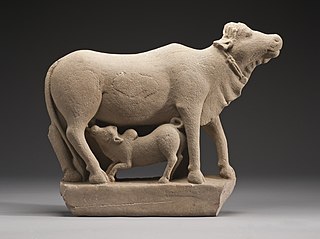
Dairy plays a significant part in numerous aspects of Indian society, including cuisine, religion, culture, and the economy.
References
- 1 2 3 "Market Prospects for Channel Island milk". Milk Development Council. 18 January 2010. Archived from the original on 14 March 2012. Retrieved 3 May 2012.
- ↑ "Our Range of Products - Maleny Dairies". Maleny Dairies. Retrieved 19 December 2016.
- ↑ Suthering, Jane. "CookIt! 2009 Final". The Guild of Food Writers. Archived from the original on 5 March 2016. Retrieved 4 May 2012.
- ↑ "Information about Guernsey Milk". A2 Guernsey Milk.com. Retrieved 4 May 2012.
- ↑ "Guernsey Dairy - About Us". Guernsey Dairy. Archived from the original on 15 February 2015. Retrieved 4 May 2012.
- ↑ "Jersey Dairy - Our History". Jersey Dairy. Archived from the original on 11 September 2012. Retrieved 4 May 2012.
- ↑ "Guernsey Dairy - Our Products". Guernsey Dairy. Archived from the original on 15 February 2015. Retrieved 4 May 2012.
- ↑ "All Categories Jersey Dairy Milk Packs". Jersey Dairy. Archived from the original on 4 August 2012. Retrieved 4 May 2012.
- ↑ "The Impact Agency - Gold Top Channel Island Milk". The Impact Agency. Archived from the original on 27 May 2012. Retrieved 16 May 2012.